Shares of Gulfport Energy (NYSE:GPOR) have been a tremendous performer over the past year, rising by more than 50%. Its strong hedge book and high-quality asset base have helped to keep the company relatively immune from the decline in natural gas prices over the past year. However with shares having now rallied so much, I believe investors should begin taking profits in GPOR, particularly if they believe commodity prices will rise as other firms could benefit more.
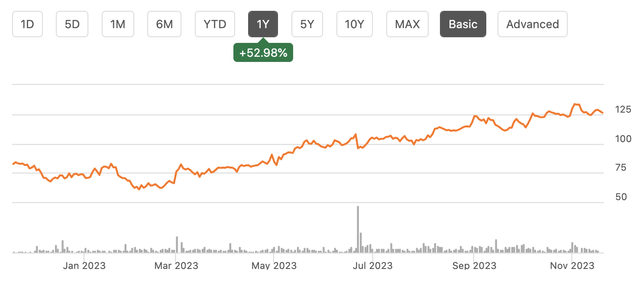
Seeking Alpha
In the company’s third quarter, GAAP EPS was $27.37, but this was significantly distorted by the recognition of its deferred tax asset of $555 million, as past losses are now recoverable, given its underlying profitability. Excluding this, it earned $2.83 a share, aided by gains on its commodity hedges. Like most of the energy sector, Gulfport is focused on returning cash flow to shareholders in an aggressive capital return program, making cash flow metrics most critical to track. During the quarter, the company generated $49 million of free cash flow and has earned $113 million in free cash flow year to date.
With this cash flow, GPOR does two things. First, it makes modest discretionary acreage purchases to deepen its inventory, which now extends out ten years. It is making about $40 million of purchases this year. With the remainder, Gulfport buys back its own shares, rather than paying a dividend. GPOR did $9 million in buybacks during the quarter and $83 million this year. This is below the $253 million last year as the commodity price environment has moderated. Still, the share count is down 3.5% over the past twelve months.
Gulfport operates primarily out of the Utica Basin (with some of its acreage bleeding into the Marcellus formation), which generates 75% of production and 71% of its cap-ex spending with the SCOOP in Oklahoma accounting for the remaining 25% of production. 90% of the company’s production is gas. While the company is relatively small, it has high quality acreage in each play. Gulfport has six of the seven top performing wells in the Utica and three of the top five in the SCOOP.
In the third quarter, production came in at 1,057mmcfe/d. I was particularly heartened to see the company increase its production guidance to 1,045-1,055mmcfe/d from 1,000-1,040 mmcfe/d while also cutting its maintenance cap-ex spending to $435-455 million from $425-$475 million. More production at less cap-ex speaks to its solid acreage and improved capital efficiency. So far this year, it has removed about $35 million from cap-ex as it has reduced cycle times by 35% this year.
At this revised level of production, maintenance cap-ex is about $0.85/mcfe. During the quarter, GPOR also had $1.12/mcfe operating costs, leading to an all-in cost structure of $1.97, which is relatively low. During the quarter though, average realizations were just $1.99. Given only a $0.02 margin, its free cash flow may seem surprisingly high. This is because the company hedges the majority of its production, and with those hedges, it realized $2.53. Having these hedges are a major positive, as they have insulated free cash flow from lower commodity prices, but this is a more of a “one-time” gain than a recurring level unless commodity prices rise.
As you can see below, natural gas prices have fallen significantly relative to 2022 levels. They surged last year as Europe was scrambling to buy every bit of LNG it could to replace the lost Russian gas in the wake of the Ukraine war. Frankly, the world and industry have mobilized to meet that demand somewhat more easily than expected, which is why prices have fallen.
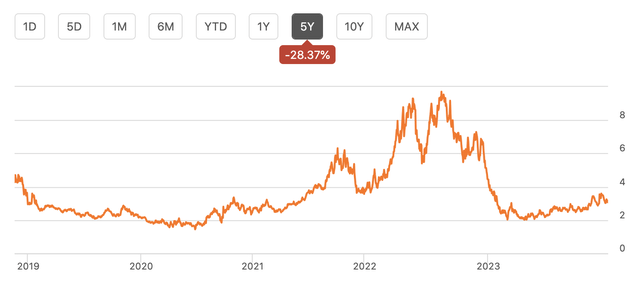
Seeking Alpha
As you can see below, piped gas to Europe fell significantly in 2022 and further this year (as Russia was still supply Europe in early 2022), according to the International Energy Agency. This has been partially offset by growth in LNG, which is slated to continue growing and should fully offset this lost gas by 2026. Frankly, given the fact markets are still relatively tight, it has been surprising to me natural gas prices have fallen quite as much as they have, in part driven by the fact some emerging countries pivoted slightly back to coal when gas prices rose so high.
.
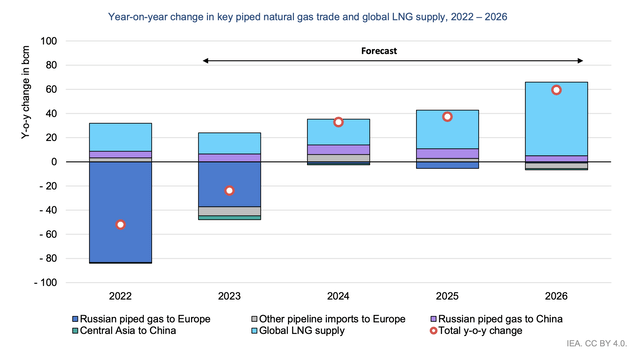
IEA
Now over the medium term, gas demand is still rising, as you can see below. Almost all of this growth is coming from China and the Middle East on net as developed world growth is expected to be negative, given growth in renewables. Unlike oil, which operates as a truly global market, natural gas is a semi-local/semi-global market. This is because the cost of liquefication and transportation is high, and the supply of tankers is finite. This is why US natural gas prices remain much lower than Europe. While Europe can buy some of our gas, trade and transport of this commodity is not frictionless, allowing wide differentials to persist in a structural manner.
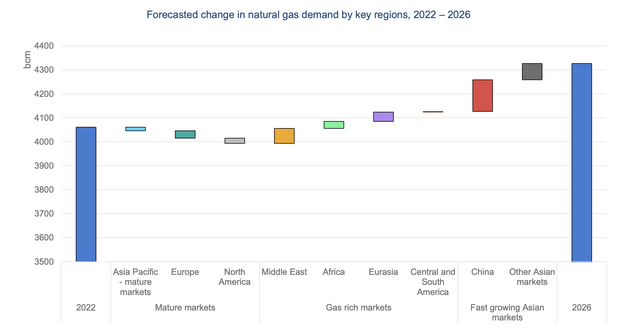
IEA
All else equal, US producers like Gulfport would see higher natural gas realizations if global demand was the same as the IEA predicted but China grew less and North America grew more, given these frictions and limited ability to reach the more lucrative export market. Nonetheless, global demand growth should provide some tailwind, just not as a large of one as may be initially expected.
Now, as noted above, GPOR has benefitted from hedges, and these hedges persist through next year, as you can see below. It has hedged about 60% of next year’s production at an average of $3.77. It has also even begun to layer in hedges for 2025. These hedges mean that the company will still continue to generate free cash flow even in a depressed commodity price environment. Based on the current forward curve, it expects to generate about $200-220 million of free cash flow over the next year, for about a 9% free cash flow yield.
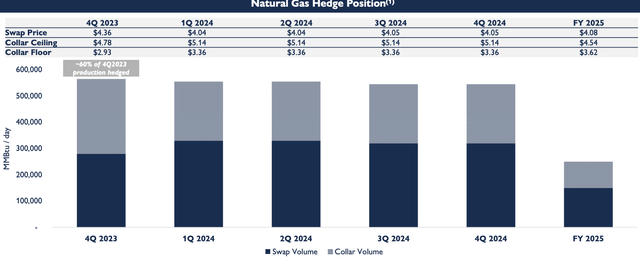
Gulfport Energy
This provides a solid level of capital returns for shareholders. With natural gas at $3 though, free cash flow would likely decline in 2025 somewhat as these more lucrative hedges roll-off. Now over the next five years, if natural gas is $3.50, GPOR believes it has $2.1 billion in free cash flow capacity. That represents 88% of its market capitalization, which would allow for significant capital returns.
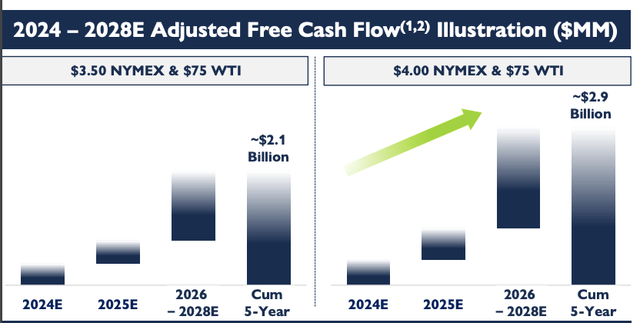
Gulfport Energy
With each $0.50 of NYMEX worth about $800 million of free cash, its capital returns would be closer to $1.3 billion over the next five years. That is about 10% per annum, which is still a reasonable return, but not quite as compelling, and more consistent with free cash flow yields offered in the energy sector.
Now, I would also note that GPOR has a strong balance sheet, which combined with its hedge portfolio, makes it a fairly defensive and resilient company. It has just 0.9x debt to EBITDA leverage $95 million on its credit facility and a $550 million maturity in 2026 at an 8% coupon. The lack of near-term maturities makes it fairly immune from higher interest rates. I would be clear that GPOR is a strong company; however with its stock rise this year, the market is now recognizing that fact.
With 60% of its 2024 production hedged, I would expect GPOR to hold in better than peers if prices fall further, though that still would be a negative for the company. If prices were to rise, it only sees a partial benefit, given its hedges, and I would expect shares to underperform a company like EQT (EQT), just as hedges allowed it to outperform this year.
With a 9-10% free cash flow yield in the current environment, I see shares as having converged to fair value. For those bullish on natural gas, I would look at more beaten-up, less-hedged names. However, given the local nature of the market and strong US production, I prefer investing in oil exposed names to gas exposed names as that is a more global market that is relatively tight still. With strong free cash flow yields, I would see better opportunity in Diamondback (FANG) and EOG (EOG) and would use GPOR”s relative outperformance as an opportunity to sell and rotate into those companies.
Read the full article here





